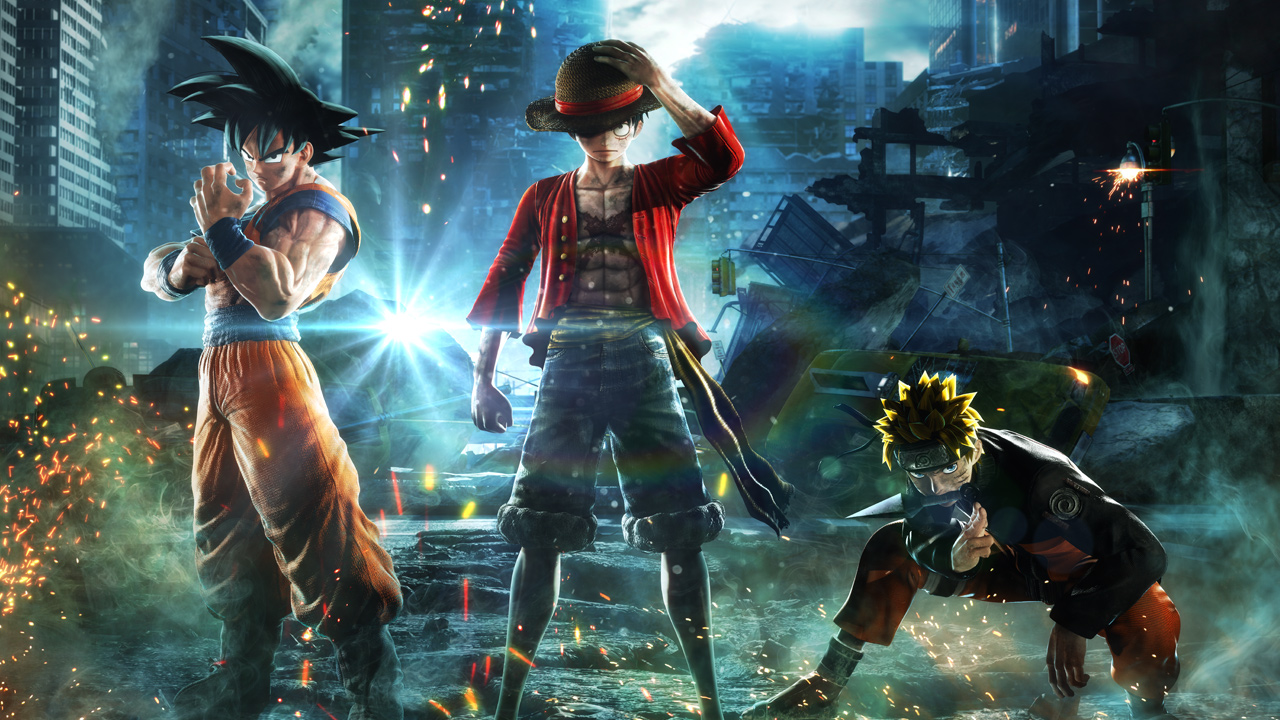To celebrate the 50th anniversary of Weekly Jump, the highly successful manga magazine, Jump Force has pulled together stars from throughout its history to do battle with one another. Pitting the likes of Goku against Kenshin or Ichigo against Seiya, fans will get to settle age-old debates and “what if?” scenarios in 3v3 arena style combat.
Jump Force developer Spike Chunsoft seemed to take much of its inspiration for Jump Force from Dimp’s highly successful Dragonball Xenoverse series. From the hub-style world with a variety of kiosks serving as where you pick up quests, shops, rewards, and starting multiplayer, the skill and ability systems, and even the combat controlling similarly. Except, this game doesn’t do them as well as the previously mentioned two-and-a-half-year-old title.
In regards to virtually every aspect of the title, I find that the best way to describe Jump Force is a rough unpolished gemstone. There is quality here but in almost all aspects, it lacks the polish and quality to make it shine in the crowded gaming market of 2019.
At the start of the story of Jump Force, you are a normal human in the real world that gets caught up in a fight between the powerhouses that are Goku and Frieza from Dragonball Z. Unfortunately, being a weak frail normal person, you fill in for Krillin, taking a finger beam from Frieza, leaving you in a precarious state and having to be revived as a hero! From here, you are recruited into the Jump Force by its Director, leader of the heroes, and are tasked with unraveling the mystery of the Umbras Cubes that have corrupted other Jump universe characters, freeing them, and stopping the big bad. All while the real world, which is merging with the Jump worlds, is assaulted by various villains and their evil henchmen, the Venoms.
The story gives you a fine enough reason that all these characters are teaming up together and the interaction between the various characters can give you a good chuckle. While there are cutscenes that are voiced, many are silent and left with the characters standing around the Jump Force’s Director’s desk as he briefs you on the next mission and the next character you have to free from the villain’s control. It’s unfortunate that the only dub option is with the original Japanese voice actors, and while they do a fantastic job, I would have loved to hear the old English voice casts from these shows come back to reprise their roles.

The roster sports an impressive 40+ characters at launch with 9 additional incoming but 18 of them come from only three series. As a game that is supposed to celebrate 50 years of Shonen Jump, it’s a shame how skewed the roster is. I have a soft spot and fond memories growing up with Naruto, Dragonball, and One Piece, but with other big series being completely absent (pour one out for Ultimate Muscle and Gintama) had Chunsoft opted for limiting series to no more than three characters per series, this could have made for a much more varied and true celebration, of Jump.
In terms of the visual presentation itself, another rough gem. The attempt to make anime characters more realistic has never been my favorite look, and I know that is just personal taste and some fans really do like the aesthetic in Jump Force, but I can’t help but think this game suffers from one of the same pitfalls that Marvel vs. Capcom Infinite suffered from. With the likes of the Naruto Ultimate Ninja Storm, Xenoverse and upcoming One Piece WorldSeeker titles perfectly capturing the anime look, I’d love to have seen that same quality and perfect representation of the anime look here in Jump Force.
Creating your own custom anime hero was one area that I was most interested to see in Jump Force and it follows the trend of the rest of the game. While you are given a great variety of options in terms of outfits, accessories, abilities, and hairstyles to choose from, pulled from the series present, even letting you make characters not present in the game, the system still falls short of being truly great. Many of the outfits, even the full sets that change all of the characters, suffer from clipping hair and objects through one another. While I accept that not every single combination of choices can be tested, the ones that remove all clothing and replace the entire outfit, I am less accepting of. Seeing half your head clipping through your collar or shirt tends to lessen the drama and intensity of a scene.
Whereas all the existing characters on the roster will experience their clothing get more and more destroyed as they take damage, wear-and-tear is all but missing from your custom character. Even though you can wear many of the same outfits as the main cast, your clothes just get dirty. Since so many of the outfit choices are pieces from the roster, it would have been nice to have the same damage shown on your custom character’s outfit too.
What I found especially disconcerting was the lack of any real facial animation on the character creator characters from the mouth up. Whether it is during a large final attack, an emotional cutscene, or walking around the central hub, your character will retain the same expression, and without the ability to change the eyes on your creation (one of the very few aspects you can’t change whenever you wish) it can make for many awkward scenes. In my case, my choice of eyes to try and give the vibe of a distant bad-ass turned out just making him look like an emotionless doll that just would stand there during cutscenes. I found it even more out of place during many ultimate attacks, many which zoom close and focus on the character’s face. Goku’s Super Spirit Bomb, which would normally feature a screaming Goku with a strained expression, is instead done by someone with a blank stare.

Some of the characters look markedly better than others, usually being those that have more normal human proportions. These are characters like Yusuke or Ichigo, while others, especially the Dragonball cast, look… not as good.

Animations are also in a bit of a rough state with navigating through the hub area being the worst offender. The running animation is jittery and done in what I think is supposed to be an exaggerated anime style but instead comes off as just odd. Your character will move slightly before you actually look like you are running due to the strangely long lead up between your characters stationary state and their movement animations. Luckily, the animations in combat fair better with only the occasional questionable transition between animations and strange movements.
Combat happens in an open arena with two teams of three fighters battling it out in over-the-top anime style, with each team’s three combatants sharing a single health bar. Fights play out and control very similarly to other arena fighters in Bandai Namco’s library with players having access to a light and heavy attack, a throw, block, a dash move to close the distance or get out of pressure, a jump, a charge button that lets you fill special gauge, access to four special attacks including an ultimate attack, and then a transformed powered-up state.

While the combat itself is on the simpler side, the complexity comes from the added abilities and buffs that you can add to your attacks that can make all the difference. From increasing the damage, applying debuffs to the enemy when a specific attack hits or buff your own stats as examples. Decisions like these help mix things up when playing against friends or random players online in the game’s multiplayer modes. You will need all the help you can get to differentiate your characters from your foes because should you both have been playing the same character, there is no real discernable difference their appearances to tell whose is whose. No alternate color schemes or costumes for characters. This omission is particularly glaring in such a visually chaotic battlefield once battles get underway, and you can easily get mixed up as to which character you are controlling.
Closing Comments:
As a fan who grew up with many of these anime, I was really hoping to like this game more than I find myself doing. From the roster, the character creator, and just the concept of what Jump Force is as a celebration of Jump’s history, the end product is not greater than the sum of its parts. For each fun moment I had, it was marred by rough and unpolished animations or mechanics. The character creator, while you have many options available to you, are pricey to purchase and whose faces simply can’t express emotion. The roster is large at launch but unless you like the big three franchises of Jump, then you will be unimpressed by almost half the cast. Examples like these just pop up in all areas of the game, and at the end of the day, I’m just left feeling …underwhelmed. Making me wish we could get a sequel to Jump Ultimate Stars that blessed the Nintendo DS in Japan. It will be interesting to see what Chunsoft adds to Jump Force with the DLC packs, but as it stands right now unless it is incredibly impressive, I don’t see myself jumping back into this one.

This game was reviewed on a PlayStation 4 Pro system with a retail copy provided by the publisher, Bandai Namco.






